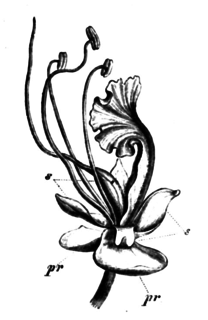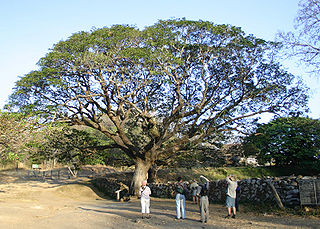
Mimosa is a genus of about 400 species of herbs and shrubs, in the mimosoid clade of the legume family Fabaceae. The generic name is derived from the Greek word μῖμος (mimos), an "actor" or "mime", and the feminine suffix -osa, "resembling", suggesting its 'sensitive leaves' which seem to 'mimic conscious life'.

Menispermaceae is a family of flowering plants. The alkaloid tubocurarine, a neuromuscular blocker and the active ingredient in the 'tube curare' form of the dart poison curare, is derived from the South American liana Chondrodendron tomentosum. Several other South American genera belonging to the family have been used to prepare the 'pot' and calabash' forms of curare. The family contains 68 genera with some 440 species, which are distributed throughout low-lying tropical areas with some species present in temperate and arid regions.

Senna, the sennas, is a large genus of flowering plants in the legume family. This diverse genus is native throughout the tropics, with a small number of species in temperate regions. The number of species is estimated to be from about 260 to 350. The type species for the genus is Senna alexandrina. About 50 species of Senna are known in cultivation.
Borismene is a monotypic genus of plant in the family Menispermaceae native to the Amazon Rainforest. The Plant List recognises the single species Borismene japurensis.

Dalea is a genus of flowering plants in the legume family, Fabaceae. Members of the genus are commonly known as prairie clover or indigo bush. Its name honors English apothecary Samuel Dale (1659–1739). They are native to the New World, where they are distributed from Canada to Argentina. Nearly half of the known species are endemic to Mexico. Two species of Dalea have been considered for rangeland restoration.

Marina is a genus of legumes. They are known as the false prairie clovers. Unlike the related prairie clovers, which bear two ovules per fruit, false prairie clovers bear only one ovule per fruit.

Rupert Charles Barneby was a British-born self-taught botanist whose primary specialty was the Fabaceae (Leguminosae), the pea family, but he also worked on Menispermaceae and numerous other groups. He was employed by the New York Botanical Garden from the 1950s until shortly before his death.

Macrolobium is a legume genus in the subfamily Detarioideae. It is a tropical genus with about 80 species. Half occur in Brazil, where they are common in the floodplains of the Amazonian Basin. Members of the genus are used as ornamentals and for their wood.

Psorothamnus is a genus of plants in the legume family. These are shrubs and small trees. Many are known by the general common name indigo bush. Some are referred to as daleas, as this genus was once included in genus Dalea. These are generally thorny, thickly branched, strongly scented bushes. Most species bear lupinlike raceme inflorescences of bright purple legume flowers and gland-rich pods. Psorothamnus species are native to the southwestern United States and northern Mexico. The genus is paraphyletic and it has been proposed that the genus Psorodendron be reinstated to accommodate sections Xylodalea, Capnodendron, and Winnemucca.

Dicymbe is a genus of 20 species of canopy trees in the family Fabaceae, within subfamily Detarioideae. It is found throughout the Guyana Shield region and parts of W Amazonia. Certain species within the genus are strongly associated with ectomycorrhizal fungi.

Samanea is a genus of flowering plants in the legume family, Fabaceae. It belongs to the mimosoid clade of the subfamily Caesalpinioideae. The type species is Samanea saman from South America.

Erythrina flabelliformis, common name chilicote or western coral bean, is a plant species native to central and northwestern Mexico and the southwestern United States. It is known from Baja California as far south as Morelos and as far east as San Luis Potosí, as well as from Arizona and New Mexico.
Curarea is a genus of flowering plants in the family Menispermaceae, found in tropical parts of Central and South America. They are dioecious lianas, with at least some species producing toxic compounds such as curare.

Astragalus aquilonius, the Lemhi milkvetch, is a species of milkvetch in the family Fabaceae. It is native to Idaho.
Telitoxicum is a genus of flowering plants belonging to the family Menispermaceae.
Disciphania is a genus of flowering plants belonging to the family Menispermaceae.
Orthomene is a genus of flowering plants belonging to the family Menispermaceae.
Sciadotenia is a genus of flowering plants belonging to the family Menispermaceae.
Elephantomene is a monotypic genus of flowering plants belonging to the family Menispermaceae. The only species is Elephantomene eburnea.











